12 Kitchen Flooring Ideas to Try, From Traditional Tiles to Sustainable Cork
If you're undergoing a kitchen renovation, you'll want to choose a kitchen floor that's durable, easy to maintain, and works with your aesthetic.
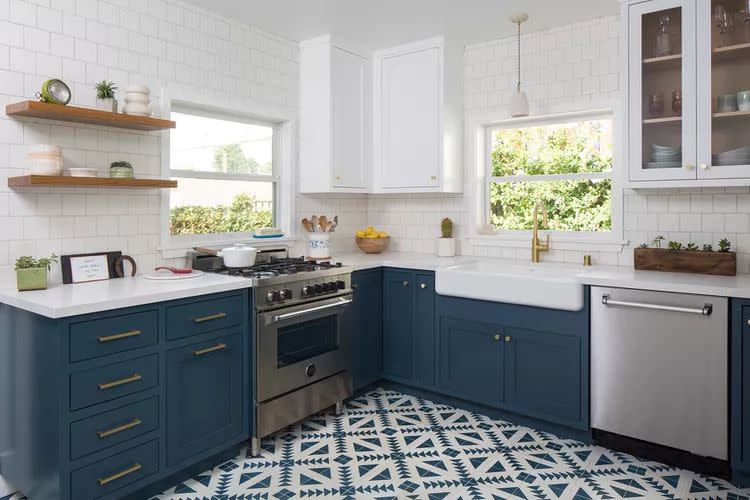
Kelly Martin / Meghan Beierle-OBrien
If you’re updating your kitchen, you've probably been saving inspirational images of cabinets, hardware, backsplash, and even appliances for some time. But before you even get to those things, you may want to make a flooring decision. Not only will your flooring choice affect all other kitchen design decisions, but it will also need to flow with the flooring in the rest of the home.
Luckily, you will not suffer from a lack of options. On the contrary, from wood to tile to concrete to stone, there are beautiful kitchen flooring options to suit all design aesthetics.
Related: 24 Beautiful Kitchen Floor Tile Ideas, From Whimsical Patterns to Bold Colors
Go Traditional With Solid Hardwood
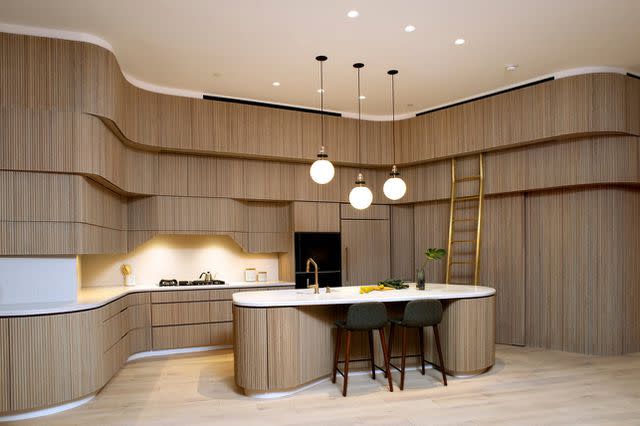
Esther Choi
There was a time when wood flooring wasn’t considered ideal in a kitchen because kitchens are high-traffic areas, and there’s always a possibility of water damage from leaky sinks or appliances. But with many newer homes utilizing open floor plans and flooring that flows seamlessly from room to room, wood floors in kitchens have made a comeback. "We are seeing wood floors in kitchens now more than ever," says Steven Skutelsky, managing partner at PID Floors. "If it is a very high traffic area, proper steps are taken so that the floors can be maintained." One of Skutelsky’s suggestions is to consider a light wood like white oak, where a scratch or a dent occurring down the road will not be as noticeable.
Try High-Tech Engineered Hardwood
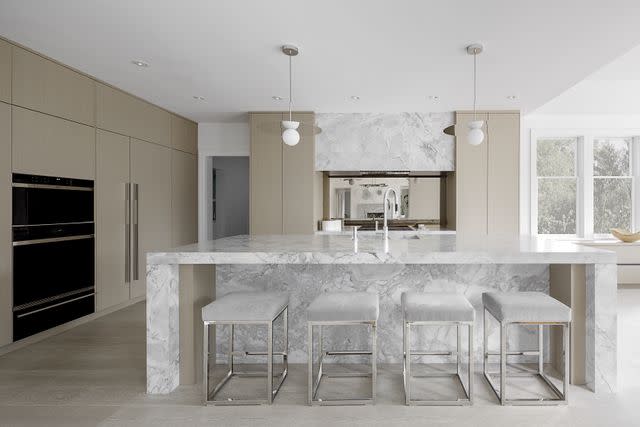
Stefan Radtke
Homeowners who are changing the flooring throughout the home in conjunction with a kitchen remodel may naturally turn to engineered wood plank because it comes pre-finished, there are many stain options, and it looks just like real wood.
In fact, it is real wood, says Skutelsky. "Solid wood flooring is made from a single piece of hardwood from top to bottom. Engineered wood floors are real wood floors that have been made with several layers of wood and slats bonded with adhesive," he says. "Both can usually be sanded and refinished, but with engineered flooring, it will depend on the thickness of the wear layer."
John Heidenry, co-founder of Red Bridge, a boutique home builder in Hoboken, New Jersey, uses exclusively engineered wood flooring in his firm’s luxury condos. "I use engineered wood because the designers like it," he says. "If you’re going to have engineered wood in the kitchen, I always suggest a floor mat at the sink to keep that area from getting worn down faster than the rest of the floor."
Related: 10 Mistakes to Avoid During Your Kitchen Renovation, According to Interior Designers
Choose Porcelain Tile for Versatility
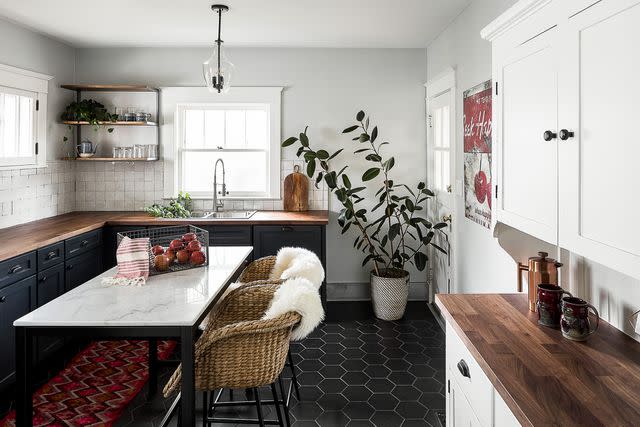
Bethany Adams Interiors
You almost can’t go wrong with porcelain tile in a kitchen. It has been a go-to kitchen flooring choice for decades because it’s beautiful, durable, and easy to maintain. "Unless a room is just too small or oddly shaped to have two different types of flooring, tile is more functional for a kitchen because of the high traffic and water," says Heidenry.
Porcelain floor tile is versatile. You can find samples in the look of marble, stone, slate, or even concrete, depending on the look you’re going for. And it’s available in multiple sizes and at many price points. "You can find porcelain for anywhere from a couple of dollars a square foot to $100 if it’s super fancy," says Heidenry, who chose a large format tile the color of concrete for his own kitchen.
Make it Classic With Ceramic Tile

Ceramic tile is similar to porcelain tile both in look and in installation; however, it’s not considered as durable as porcelain. Because ceramic tile is made of coarser clay than porcelain tile and is not fired at as high a temperature, the tiles are not as hard. Still, it’s perfectly suited to indoor uses, such as a kitchen floor. And it’s beautiful and economical—at about half the cost per square foot as porcelain tile.
Related: 12 Kitchen Design Trends to Inspire Your Renovation
Consider the Timelessness of Saltillo
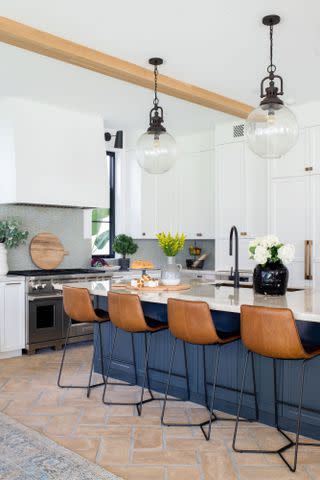
Erin Konrath
When you think about terra cotta tile, you’re likely thinking of the color terra cotta and picturing Saltillo—a kiln-fired clay tile that has been handcrafted in Saltillo, Mexico, for centuries. Saltillo is extremely durable thanks to the rich clay derived from local riverbeds. The colors are in the orange spectrum, with hues that range from light pink to peach to brown to brick-red.
Saltillo floors are a beautiful choice in a kitchen, especially if you want a Mediterranean look. It’s common in the mission-revival homes of California to see Saltillo flooring throughout the house. The look is warm and timeless and pairs very well with white walls. However, not all terra cotta-color tiles are Saltillo. And not all terra cotta tiles are even a terra cotta color!
Bring Texture With Terra Cotta Tile
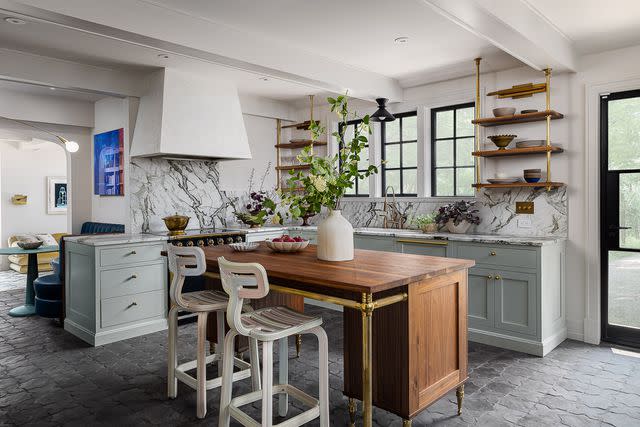
J.L. Jordan Photography
Terra cotta is kiln-fired clay tile, and it’s made around the globe in almost every color and shape imaginable. The patterns can be very intricate—which is a great way to bring added texture and dimension to a kitchen.
"We used a gray reproduction Belgian terra cotta tile, in a star and cross pattern from Clé, in this historic 1920s Tudor Revival home in Louisville, Kentucky,” says Bethany Adams, interior designer and principal at Bethany Adams Interiors. "It is a durable and beautiful foundation for the myriad other textures and finishes in this kitchen."
Related: 34 Beautiful, Functional Kitchens to Inspire Your Own
Go Modern (or) Rustic With Slate
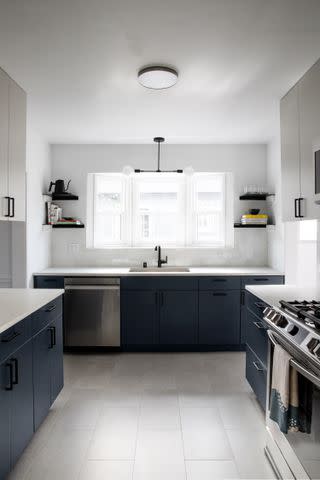
Courtesy of Block Renovation
Slate is a type of stone that can be cut into thin slabs. It has been used in flooring, both indoors and out, for centuries. The stone ranges in color from gray to bronze to olive green, but the most common choice in kitchens today is slate gray. Stone is expensive, and slate can cost up to $10 per square foot. But its rustic authenticity can’t be beat. It works great in both traditional and modern kitchens.
Slate is heavy and requires several layers of mortar and other substrates, so it’s best used in first-floor installations or in rooms that have considerable support beneath them. The stone is brittle and can crack, so the subfloor needs to be perfectly level.
Related: 10 Ways to Upgrade Your Kitchen Without Renovating It
Try Polished Concrete for an Industrial Flourish
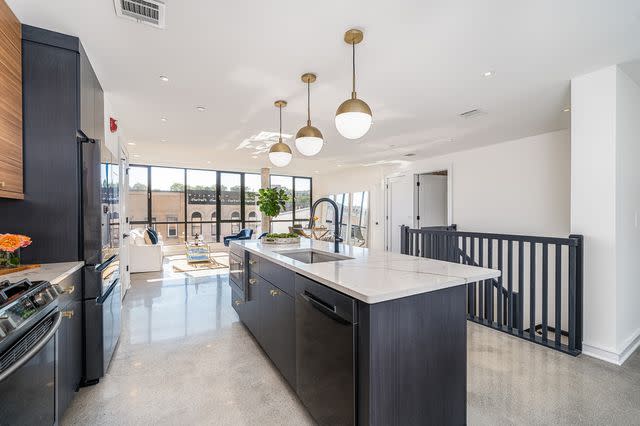
John Heidenry
Concrete is an aggregate of crumbled rock, stone, and granite mixed with cement and water. It can be sparkly or muted, depending on the aggregate. It can also be pigmented if you wish. Once dried, the surface will be ground down and polished. Concrete can also be painted, and beautiful finishes can be achieved using two-part epoxy. It can mimic the look of marble or other stone at a fraction of the price.
Polished concrete floors look stunning in modern, rustic, and industrial kitchens or any home that has an open floor plan. It’s unlikely you’d see just a kitchen floor in polished concrete—it’s typically a floor-through choice for a seamless look throughout a home. Concrete is cold underfoot unless you’re also installing radiant heat. And it does stain, so sealing is recommended. But it’s carefree to clean and maintain.
Use Luxury Vinyl Plank for High-Traffic Areas
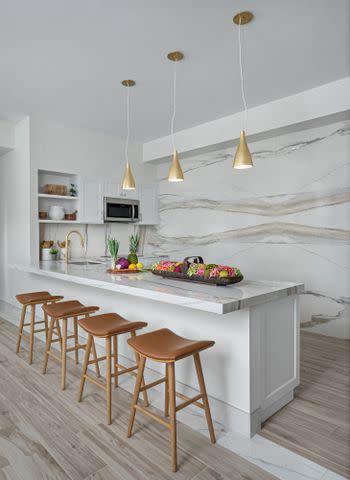
Beth Singer
You almost can’t view a home renovation show these days without hearing about luxury vinyl tile (LVT). A relative newcomer on the flooring scene, it’s been attracting buzz. "It’s a versatile option that bridges the gap from low- to high-end affordability," says Josh Rudin, founder of ASAP Restoration. "We have used gorgeous LVTs in both homes and commercial spaces. These tiles are great for high-traffic areas, depending on the thickness of the wear layer." Most systems are installed with a click/lock system, he adds, which makes them user-friendly to install.
Employ Pattern With Cement Tile
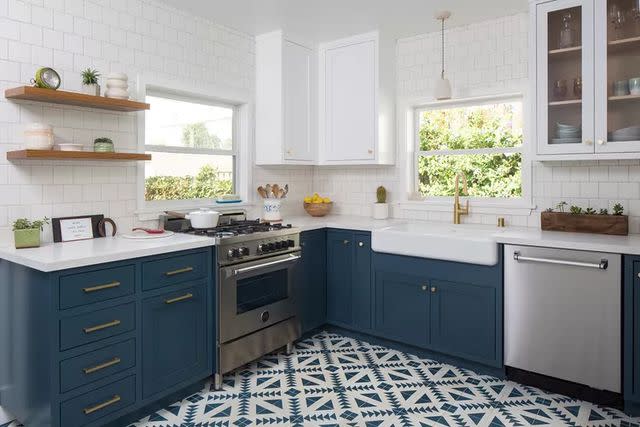
Kelly Martin / Meghan Beierle-OBrien
Cement tile has been around for centuries, but it came back in a big way with the modern farmhouse trend. Cement tiles feature very vibrant colors and patterns, such as fleur-de-lis. The tiles are typically arranged in fours to create large, bold patterns. This can provide a welcome contrast in an all-white or gray kitchen—and such a floor really pops against white shiplap. One thing to be aware of if you’re using it in a kitchen, though, is that the tiles will need to be sealed.
"Cement is a very porous surface, so if you plan to use cement tiles in the kitchen, make sure that you get them sealed properly," says Ashley Macuga, principal designer at Collected Interiors. "Unsealed cement tiles may absorb liquids to some extent, making them susceptible to staining—so be sure you are ready for the inevitable olive oil stain."
Be Sustainable With Marmoleum
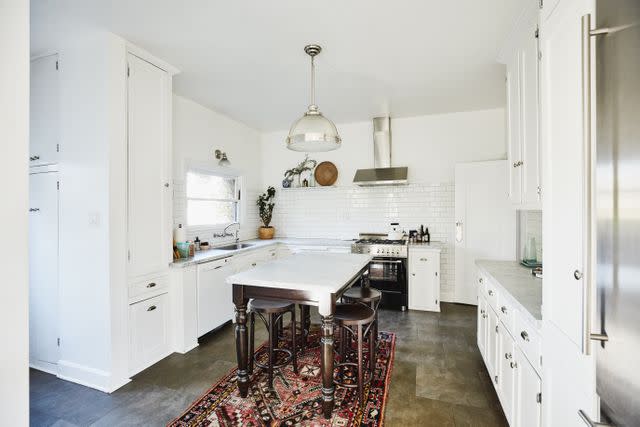
Thomas Barwick / Getty Images
Marmoleum is a brand of linoleum—but it’s nothing like the flooring you may have encountered when renovating an older home. And—surprise!—it’s one of the greenest flooring options you can choose and always has been. "Marmoleum is made today as it was almost a century ago," says Joel Hirshberg, owner and co-founder of Green Building Supply. "A truly green, eco-friendly floor, Marmoleum emits no formaldehyde, VOCs, or hazardous air pollutants, and it's climate positive."
Marmoleum is made from flax, limestone, tree rosins, wood flour, and natural pigments with a jute backing. It comes in rolls of any width, for those who are looking for a seamless flow. But other formats include modular tiles that you glue down or click-lock panels that are floated without nails or glue. It also comes in an array of colors to suit any aesthetic.
Related: 7 Kitchen Trends That Will Never Go Out of Style
Consider Cork
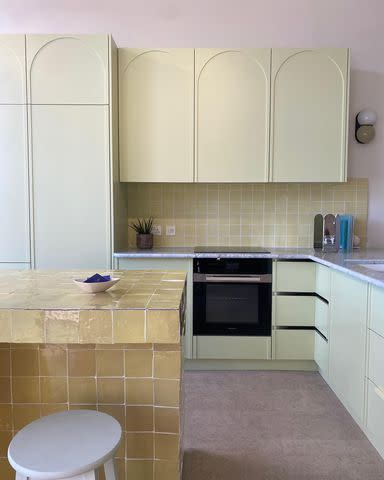
Courtesy of Kite Flooring
Another sustainable flooring option is cork. Moisture-resistant, noise buffering, and soft underfoot, cork is a great choice for a kitchen. "Cork flooring has excellent thermal and acoustical properties," says Hirshberg. "It's beautiful, lightweight, warm to the touch, hypoallergenic, fire and insect resistant, moisture resistant, and maintains just like hardwood floors. But the number-one reason people like cork flooring is because it feels soft but firm to the feet. The minute you step onto a cork floor, your knees and back relax."
Read the original article on Martha Stewart.

